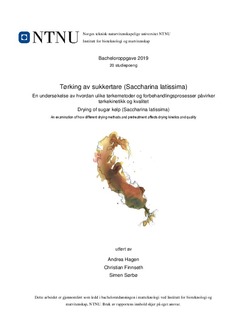| dc.contributor.advisor | Mukhatov, Kirill | |
| dc.contributor.advisor | Tolstorebrov, Ignat | |
| dc.contributor.author | Hagen, Andrea | |
| dc.contributor.author | Finnseth, Christian | |
| dc.contributor.author | Sørbø, Simen | |
| dc.date.accessioned | 2019-09-06T14:11:22Z | |
| dc.date.available | 2019-09-06T14:11:22Z | |
| dc.date.issued | 2019 | |
| dc.identifier.uri | http://hdl.handle.net/11250/2613548 | |
| dc.description.abstract | Hensikten med denne bacheloroppgaven var å finne ut hvordan ulike forbehandlinger (ubehandlet, skylt og blansjert) og tørkemetoder ville påvirke tørkekinetikk og kvalitet hos sukkertare (Saccharina latissima).
Sukkertare ble atmosfærisk tørket i klimakammer ved 60 C og 80 C (10 % RH), i tillegg ble den vakuumtørket ved 40 °C og 60 C (0,3 mbar), og vakuumfrysetørket ved -20 C (0,3 mbar). Tørkekinetikk og kvalitet ble analysert og vurdert opp mot alle forbehandlinger og tempetaturer, med unntak av vakuumfrysetørket sukkertare ved som kun ble analysert for kvalitet.
For å undersøke kvaliteten ble det analysert for fargekarakteristikk, vannaktivitet (aw), og innhold av jod (I), salt (NaCl), natrium (Na) og kalium (K). Tørkekinetikk ble analysert ved å veie sukkertaren underveis i tørkeprosessen, og analysere for vanninnhold, vannforhold, tørkehastighet, tørrstoff og vanninnhold ved likevekt.
Forsøket viste at blansjering var den forbehandling som i størst grad reduserte innhold av jod, salt, natrium og kalium. Na:K-forholdet var lavt for alle prøvene. Samtlige tørkeresultater viser til et tilstrekkelig tørt produkt med lavt vanninnhold og vannaktivitet som begrenser mikrobiell forringelse, med unntak av blansjert atmosfærisk tørket sukkertare ved 60 C.
Ut fra analysene for tørkekinetikk og kvalitet kan det konkluderes med at blansjert, vakuumtørket sukkertare ved 40 °C vil gi et produkt med høy kvalitet med tanke på konsum. Fra et kostnadseffektivt perspektiv kan det anbefales blansjert atmosfærisk tørket sukkertare ved 60 °C. | |
| dc.description.abstract | The overall purpose of this thesis was to determine how various pretreatments (raw, rinsed and blanched) and drying methods would affect the drying kinetics and quality of sugar kelp (Saccharina latissima).
The sugar kelp was atmospherically dried in a climate chamber at 60 °C and 80 °C (10 % RH). In addition, it was vacuum-dried at 40 °C and 60 °C (0,3 mbar), and vacuum-freeze-dried at -20 °C (0,3 mbar). The drying kinetics and quality were analyzed and studied at all pretreatments and temperatures, apart from vacuum-freeze-dried sugar kelp at -20 °C which were only analyzed for quality.
To examine the quality, it was analyzed for colorimetric characteristics, water activity (aw), and the content of iodine (I), salt (NaCl), sodium (Na) and potassium (K). Drying kinetics were analyzed by weighing the sugar kelp during the drying process, in order to analyze moisture content (d.b.), moisture ratio, drying rate, dry matter and equilibrium moisture content.
The experiment showed that blanching was the pretreatment that reduced the content of iodine, salt, sodium and potassium to the greatest extent out of the three treatments. The Na:K ratio was low in all samples. All of the drying results refer to a sufficiently dry product with low moisture content (d.b.) and water activity which limits microbial deterioration, with the exception of blanched atmospheric-dried sugar kelp at 60 °C.
Based on the analyzes for drying kinetics and quality, it can be concluded that blanched, vacuum-dried sugar kelp at 40 °C will produce a high-quality product for human consumption. From a cost-effective perspective, blanched atmospheric dried sugar kelp at 60 °C can be recommended. | |
| dc.language | nob | |
| dc.publisher | NTNU | |
| dc.title | Tørking av sukkertare (Saccharina latissima): En undersøkelse av hvordan ulike tørkemetoder og forbehandlingsprosesser påvirker tørkekinetikk og kvalitet | |
| dc.type | Bachelor thesis | |
